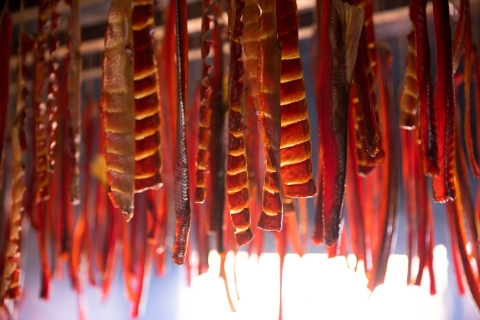About Us
Yukon Delta National Wildlife Refuge was established in 1980 to protect the wildlife and diverse habitats nestled on the delta between the mighty Yukon and Kuskokwim rivers of Alaska. Here, the tundra meets the Bering Sea. Without question, the refuge supports one of the largest aggregations of water birds in the world. A spectacle takes place every spring as millions of ducks, geese, and other water birds return to the refuge to nest. The refuge supports one of the most important shorebird nesting areas in the United States, both in density and species diversity.
Hundreds of miles of rivers and streams provide spawning and rearing habitat for 44 species of fish, including five species of Pacific salmon. Drier upland habitats harbor populations of brown and black bears, caribou, moose, wolves, and muskox. Along the coast of the refuge, the Bering Sea hosts a variety of marine mammals, including whales, which pass through during migration.
In the interior, the Andreafsky wilderness protects a large expanse of alpine and wetland tundra. An abundance of moose, fox, martens, wolverines, caribou, black and brown bears thrive. The Andreafsky River and the East Fork, a designated Wild and Scenic River, traverses 198 miles of this Wilderness area.
This landscape is the ancestral home of the Yup’ik, Cup’ik, and Deg Xit'an people of Alaska. The region is rich in culture, and residents depend on wild lands, waters, and wildlife to support an active subsistence way of life. The Yukon-Kuskokwim Delta is among the most populated rural areas in Alaska, with over 50 Alaska Native communities.
Our Mission
Yukon Delta National Wildlife Refuge was established for the following purposes under the Alaska National Interest Lands Conservation Act:
- Conserve fish and wildlife populations and their habitats in their natural diversity including, but not limited to shorebirds, seabirds, tundra swans, emperor, white-fronted and Canada geese, black brant and other migratory birds, salmon, muskox, and marine mammals;
- Fulfill the international treaty obligations of the United States with respect to fish and wildlife and their habitats;
- Provide, in a manner consistent with the purposes set forth in subparagraphs (i) and (ii), the opportunity for continued subsistence uses by local residents;
- Ensure, to the maximum extent practicable and in a manner consistent with the purposes set forth in paragraph (i), water quality and necessary water quality within the refuge.
Our History
Over the course of time, the Yukon and Kuskokwim rivers created one of the largest river deltas in the world. That delta, a generally flat marshland containing innumerable lakes and ponds, is the dominant landscape of the Yukon Delta National Wildlife Refuge. People have lived in this region which was once part of the land mass called Beringia, or Bering Land Bridge, for thousands of years. The refuge is currently home for over 25,000 people, mostly Yup'ik, who live in 35 villages within the boundaries. There are 56 communities in the Yukon Delta region.
President Theodore Roosevelt first set aside lands here in 1909 as a preserve and breeding ground for native birds. In 1929, Nunivak Island became established as a refuge and breeding ground for wild birds, game, and furbearing animals. In 1930, the small islands and all lands under the waters surrounding Nunivak Island were added to the refuge. Additional lands were reserved by President Franklin D. Roosevelt in 1937 when Hazen Bay Migratory Waterfowl Refuge was established. The Kuskokwim National Wildlife Range, established in 1960, was enlarged in 1961, and its name changed to the Clarence Rhode National Wildlife Range.
On December 2, 1980, President Jimmy Carter signed the Alaska National Interest Lands Conservation Act (ANILCA). The enactment of ANILCA established Yukon Delta National Wildlife Refuge by combining these existing ranges and refuges . Through ANILCA, Congress also established the Andreafsky and Nunivak Wilderness Areas and designated the Andreafsky River as a Wild and Scenic River. With the exception of several small additions to the refuge through land exchanges or purchases, all lands that now make up the refuge were in the public domain prior to refuge designation.





